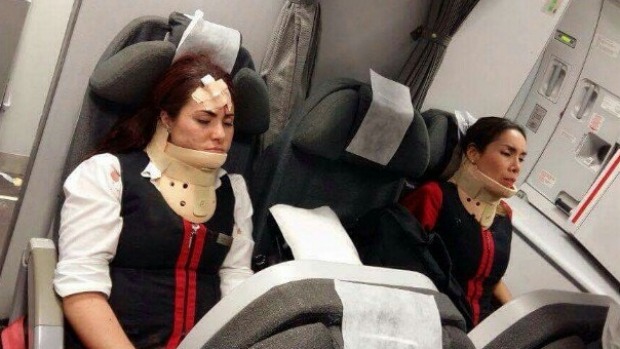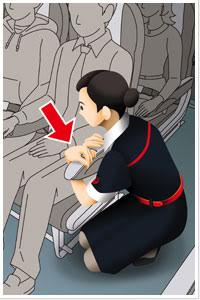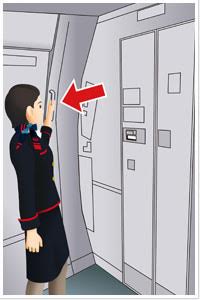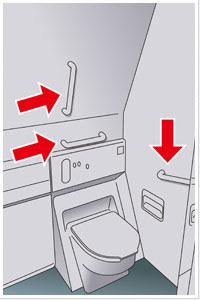- City Fajr Shuruq Duhr Asr Magrib Isha
- Dubai 04:25 05:43 12:19 15:46 18:50 20:09

Passengers not wearing seat belts expose themselves and fellow passengers to severe injury. (Twitter)
"Ladies and gentlemen, the captain has turned on the fasten seat belt sign," when flight attendants make this announcement take it seriously.
Mid-air turbulence can not only be uncomfortable but also turn dangerous if you do not follow the safety rules.

An injured passenger of Etihad Flight EY474 receives medical treatment at the health facility at Soekarno-Hatta International Airport in Cengkareng, in the outskirts of Jakarta, Indonesia, Wednesday, May 4, 2016. (AP)
Recently, we have read several news reports of shocking injuries after severe turbulence hits flight.
These incidents are a reminder that fastening seatbelt on an aircraft is a good idea even when you are sleeping.
Turbulence is not generally dangerous to the aircraft itself, airplanes are engineered to endure these forces but inside the cabin there is a substantial risk of unsecured objects and people being thrown around.

Severe turbulence injures 23 on Avianca Airbus from Lima to Buenos Aires in June 2016. Twitter/TrafficAirColom
A pilot from a commercial airline, requesting anonymity, spoke to Emirates 24|7 and said, "When passengers do not wear seat belts they along with fellow passengers are exposed to severe injury.
"When an aircraft encounters turbulence, passengers may be flung from their seat, they may be lifted briefly out of their seat and then return abruptly back down, possibly on an armrest, a galley cart or another passenger.
"Despite seeing the seat belt sign, if a passenger is walking about, the potential for injury from falling or landing awkwardly on hard objects during a turbulence is even greater. Therefore, observing and obeying the fasten seat belt sign is a key safety precaution."

Four passengers and 3 attendants were taken to hospital after an American Airlines plane from Miami to Milan in January 2016. (AFP)
Flight attendants always urge passengers to fasten belt even when the seat belt sign is turned off, so as to prepare for sudden rocking of the aircraft. If passengers are using a blanket, seat belts should be secured over the blanket.
Flight attendant Nuralia Mazlan, from JetBlue Airways says on Quora that several passengers remove seat belt and get up even as the aircraft is taxing after landing, the plane may move again after stopping, it is necessary to remain seated until the seat belt sign is turned off.

Five crew members and one passenger were injured after Thai Airways Boeing 777 experienced severe turbulence in April 2016. Facebook
Mazlan says, "Everyone boards a plane to go somewhere and ultimately get off the plane, but the seat belt sign is on for some reason. It's for passenger safety."
Mazlan clarifies, "I know you're eager to exit the aircraft - me too. But if I to have an injured passenger on board their health would be in jeopardy now because this other passenger refuses to obey the regulations and instead chooses to be selfish.
"What if the captain brakes suddenly while taxing down the runway? You'll be thrown forward, injuring yourself and probably others. Pease be seated and we can all be on our way once the captain says so."
During take-off and landing passengers should fasten the seat belt securely and low, and make sure it is not loose to protect your body from shocks in an emergency.
In case of sudden turbulence
During flight, aircraft may encounter unexpected turbulence without any time to turn on the seatbelt sign. In this case, you should quickly support your body to prevent yourself from falling or being thrown off balance.
First, sit in the nearest empty seat and fasten the seatbelt. If there are no empty seats nearby, squat down and grasp a secure object.
If you are in the aisle, hold on to an armrest. If you are near or inside the lavatory, grasp the handle.
In the aisle
Squat down and remain low. Grasp the nearest seat or armrest. Hold the armrest from below to prevent your body from lurching upward.

Near the lavatory
Hold on to a handle near the lavatory.

Inside the lavatory
Remain low and hold on to the handle.

![]() Follow Emirates 24|7 on Google News.
Follow Emirates 24|7 on Google News.